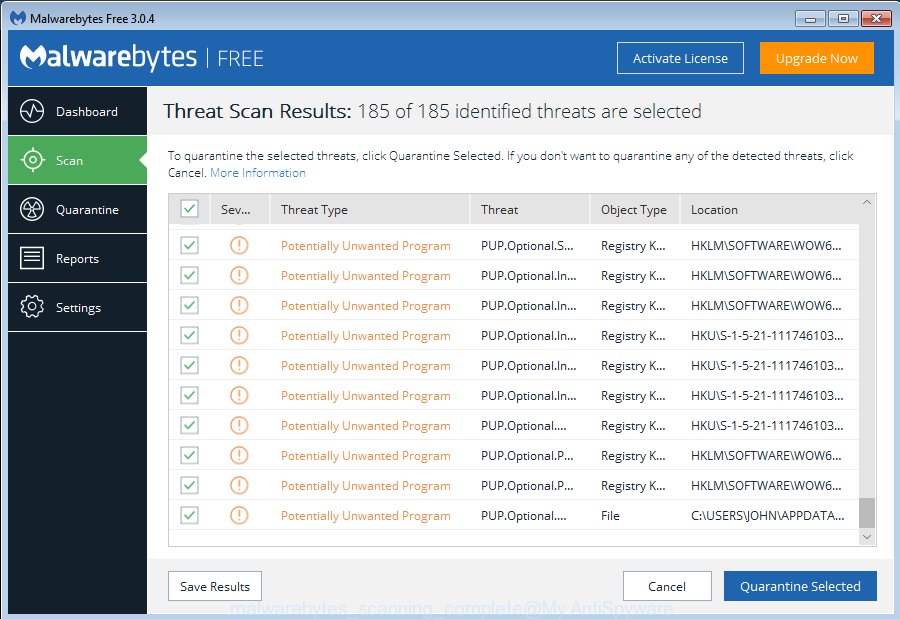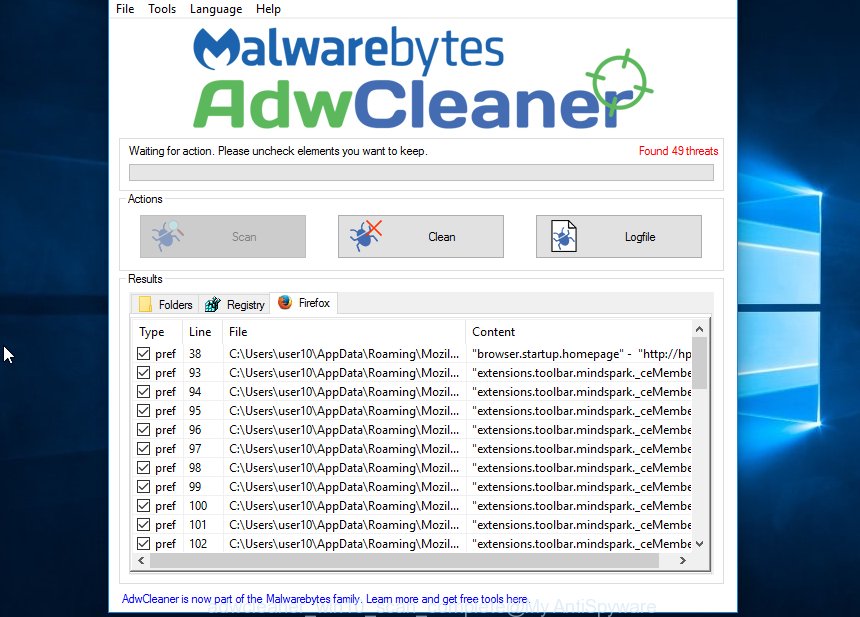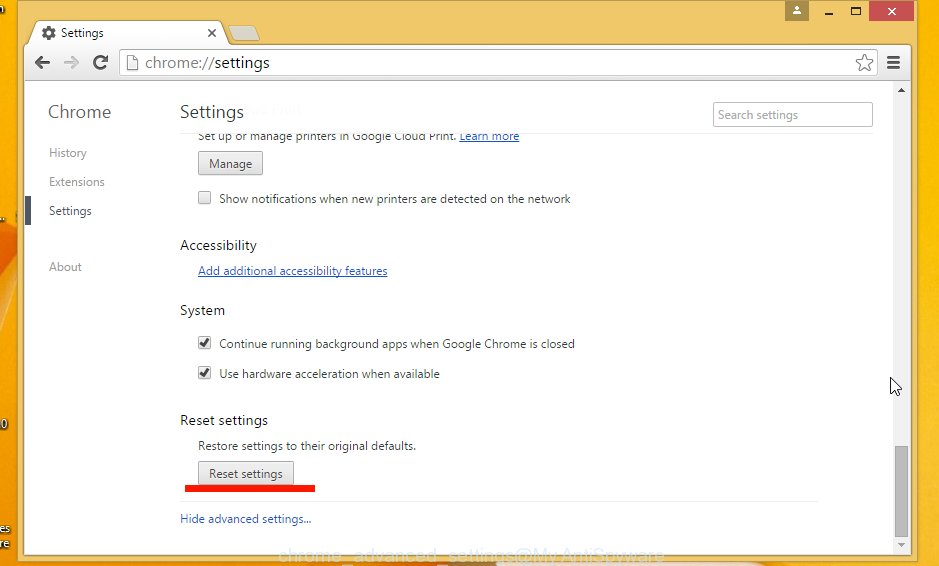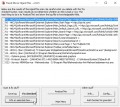If your antivirus detects Trojan/Wdfload which also known as Win32/Wdfload, Trojan:Win32/Wdfload, Trojan:Win64/Wdfload then it indicates that your computer is infected with a Trojan Horse malware. This malicious software usually come with some freeware or from malicious websites that ask users to download and run a Flash Player or Java update. Once started, the Trojan/Wdfload will be configured to start automatically when Windows starts. The unwanted software may display large number unwanted popups, inject ads into web-pages that you are opening in the Internet browser, hijack the web-browser’s settings such as homepage and search engine, download another malware, use your PC for click fraud and so on.
So , if you find that your antivirus software detects the Win32/Wdfload threat, then don’t wait! You need to follow the step-by-step guide below as soon as possible. The steps will assist to remove Trojan/Wdfload and any associated malware for free.
Common symptoms of Trojan/Wdfload
If you still are not sure that your computer is infected with this parasite, then check your computer for the common symptoms of the infection:
- Your browser displays banner ads where previously you have never seen.
- Google Chrome, Mozilla Firefox and Microsoft Internet Explorer (Edge) shows a lot of annoying advertisements.
- Web browser’s settings such as homepage and default search engine are hijacked
- Your an antivirus or antispyware software detects an infection.
- Internet connection may be slow.
How to remove Trojan/Wdfload
The following instructions is a step-by-step guide, which will help you manually remove Trojan/Wdfload and clean your computer.
- Scan your computer with MalwareBytes Anti-malware
- Scan your computer with AdwCleaner
- Scan your computer with Kaspersky Virus Removal Tool
- Disinfect browser’s shortcuts
- Reset web-browser’s settings
- Protect your computer from annoying ads and malicious sites
Scan your computer with MalwareBytes Anti-malware
Delete Trojan/Wdfload malware manually is difficult and often the malicious software is not completely removed. Therefore, we recommend you to use the Malwarebytes Free which are completely clean your PC system. The Malwarebytes is a reputable malware removal program. It can automatically detect and remove a Trojan Horse malware of the your computer. Moreover, this free program will help you to remove internet browser hijackers, malware and toolbars that your personal computer may be infected too. You can follow the step-by-step guide below to remove the Trojan/Wdfload unwanted pop-ups completely.
Download Malwarebytes Free from the link below.
327001 downloads
Author: Malwarebytes
Category: Security tools
Update: April 15, 2020
Once downloaded, close all applications and windows on your machine. Open a directory in which you saved it. Double-click on the icon that’s named mb3-setup like below.
![]()
When the install starts, you will see the “Setup wizard” which will help you install Malwarebytes on your PC.

Once installation is finished, you will see window as shown below.

Now click on the “Scan Now” button to begin checking your machine for Trojan/Wdfload malware. This process can take some time, so please be patient.

When the system scan is finished, make sure all entries have “checkmark” and click “Quarantine Selected” button. The Malwarebytes will start removing the malicious software related files, folders, registry keys. When the disinfection is finished, you may be prompted to restart the machine.
The following video explains the guide above on how to delete ad supported software with Malwarebytes Anti-malware.
Scan your computer with AdwCleaner
If MalwareBytes cannot remove the annoying Trojan/Wdfload from your personal computer, then we suggests to use the AdwCleaner. AdwCleaner is a free removal tool for ad-supported software, malware, browser hijackers, PUPs and toolbars.
Download AdwCleaner from the link below.
225511 downloads
Version: 8.4.1
Author: Xplode, MalwareBytes
Category: Security tools
Update: October 5, 2024
After downloading is finished, open the file location. Double click the AdwCleaner icon. Once this tool is started, you will see a screen like below.

Now, click the “Scan” button to perform a system scan for the Trojan/Wdfload malware. Once the scanning is finished, it will show a scan report as shown below.

Review the report and then click “Clean” button. It will open a prompt. Click “OK”. Once the cleaning process is complete, AdwCleaner may ask you to reboot your PC.
Look at the following video, which completely explains the process of using the AdwCleaner to delete adware, browser hijackers and other malicious programs.
Scan your computer with Kaspersky virus removal tool
Kaspersky virus removal tool is a well-known free security tool. It uses the Kaspersky Anti-Virus engine to detect and remove viruses, trojans and malware.
- Download Kaspersky virus removal tool from the following link and save it directly to your Windows Desktop.
Kaspersky virus removal tool
129216 downloads
Author: Kaspersky® lab
Category: Security tools
Update: March 5, 2018
- Double-click on the KVRT icon found on your desktop. Once initialization process is finished, you will see the Kaspersky virus removal tool screen.
- Click Change Parameters and set a check near all your drives. Click OK to close the Parameters window.
- Press “Start scan” button. Kaspersky virus removal tool will now start scanning your computer for known infections. This procedure can take some time, so please be patient.
- When KVRT has finished scanning, click on Continue to start a cleaning process.
Disinfect browser’s shortcuts
When the Trojan:Win32/Wdfload is started, it can also change the browser’s shortcuts, adding an argument like “http://site.address” into the Target field. Due to this, every time you open the web browser, it will be rerouted to an unwanted advertisements.
To clear the web-browser shortcut, right-click to it and select Properties. On the Shortcut tab, locate the Target field. Click inside, you will see a vertical line – arrow pointer, move it (using -> arrow key on your keyboard) to the right as possible. You will see a text which starts with “http://” which has been added here. You need to remove it.

When the argument is removed, click the OK button. You need to clean all shortcuts of all your browsers, as they may be infected too.
Reset web-browser’s settings
Chrome
Like other modern internet browsers, the Google Chrome has the ability to reset the settings to their default values and thereby remove the redirect to annoying advertisements that is caused by the Win32/Wdfload malware.
At first, start the Chrome. Next, click the button in the form of three horizontal stripes (![]() ). It will appear the main menu. Click on the option named “Settings”. Another way to display the Chrome’s settings – type chrome://settings in the web-browser adress bar and press Enter.
). It will appear the main menu. Click on the option named “Settings”. Another way to display the Chrome’s settings – type chrome://settings in the web-browser adress bar and press Enter.

The internet browser will open the settings screen. Scroll down to the bottom of the page and click on the “Show advanced settings” link. Now scroll down until the “Reset settings” section is visible, as shown on the screen below and press the “Reset settings” button.

The Google Chrome will display the confirmation prompt. You need to confirm your action, press the “Reset” button. The program will start the procedure of cleaning. When it is done, the internet browser settings including the ‘block pop-ups’ option back to the values that have been when the Google Chrome was first installed on your machine.
Firefox
Open Mozilla Firefox menu by clicking on the button in the form of three horizontal stripes (

In the Help menu click on the “Troubleshooting Information”. In the upper-right corner of the “Troubleshooting Information” page click on Refresh Firefox button.

Confirm your action. Click on the Refresh Firefox.
Internet Explorer
Open the Internet Explorer tools menu by clicking on the button in the form of gear (

In the Internet Options window click on the Advanced tab, then click the Reset button. The Internet Explorer will show the Reset Internet Explorer settings window. Select the Delete personal settings check box, then click on Reset button.

You will now need to restart your computer for the changes to take effect.
Protect your computer from annoying ads and malicious sites
To increase your security and protect your computer against new annoying ads and malicious pages, you need to use an application that blocks access to dangerous ads and sites. Moreover, the application can block the show of intrusive advertising, that also leads to faster loading of pages and reduce the consumption of web traffic.
- Download AdGuard application from the following link.
Adguard download
26825 downloads
Version: 6.4
Author: © Adguard
Category: Security tools
Update: November 15, 2018
- After downloading is complete, start the downloaded file. You will see the “Setup Wizard” window. Follow the prompts.
- Once the setup is finished, press “Skip” to close it and use the default settings, or press “Get Started” to see a quick tutorial which will allow you get to know AdGuard better.
- In most cases, the default settings are enough and you do not need to change anything. Each time, when you start your PC system, AdGuard will run automatically and stop ads and unwanted pop-ups, as well as other harmful or misleading web sites. For an overview of all the features of the program, or to change its settings you can simply double-click on the AdGuard icon, that is located on your Windows desktop.
Finish words
Once you have complete the step-by-step instructions shown above, your PC system should be clean from the Trojan/Wdfload and other malware. The Google Chrome, Internet Explorer, Firefox and Edge will no longer display annoying pop-up ads and redirect you to unknown sites. Unfortunately, if the few simple steps does not help you, then you have caught a new type of ad supported software, and then the best way – ask for help.
- Download HijackThis from the link below and save it to your Desktop.
HijackThis download
4866 downloads
Version: 2.0.5
Author: OpenSource
Category: Security tools
Update: November 7, 2015
- Double-click on the HijackThis icon. Next click “Do a system scan only” button.
- Once the checking is finished, the scan button will read “Save log”, press it. Save this log to your desktop.
- Create a Myantispyware account here. Once you’ve registered, check your e-mail for a confirmation link, and confirm your account. After that, login.
- Copy and paste the contents of the HijackThis log into your post. If you are posting for the first time, please start a new thread by using the “New Topic” button in the Spyware Removal forum. When posting your HJT log, try to give us some details about your problems, so we can try to help you more accurately.
- Wait for one of our trained “Security Team” or Site Administrator to provide you with knowledgeable assistance tailored to your problem with the Trojan/Wdfload malware.





















